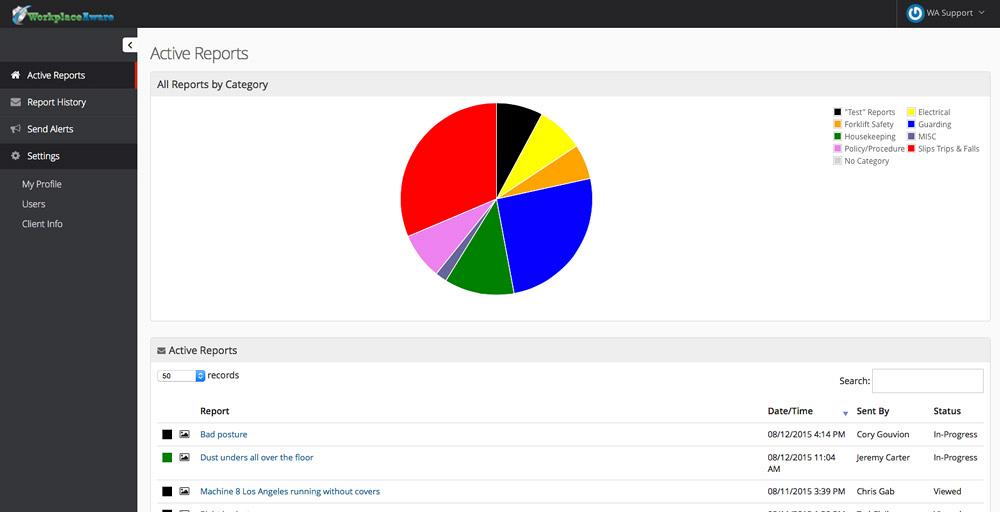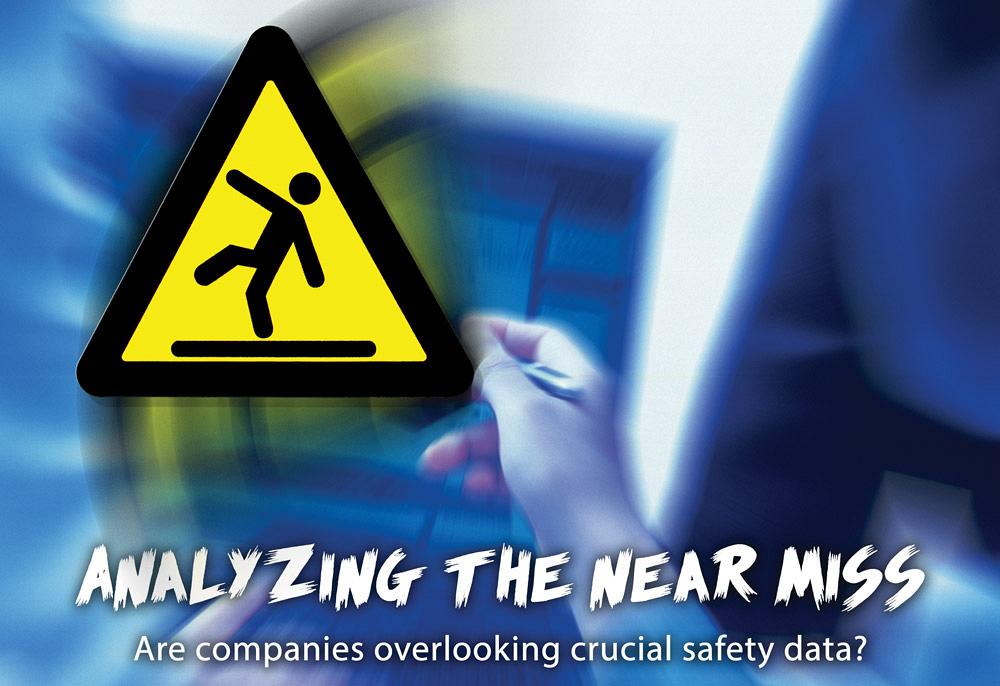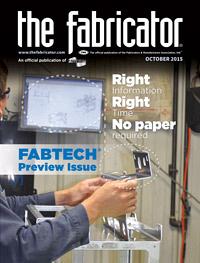Founder and CEO
- FMA
- The Fabricator
- FABTECH
- Canadian Metalworking
Categories
- Additive Manufacturing
- Aluminum Welding
- Arc Welding
- Assembly and Joining
- Automation and Robotics
- Bending and Forming
- Consumables
- Cutting and Weld Prep
- Electric Vehicles
- En Español
- Finishing
- Hydroforming
- Laser Cutting
- Laser Welding
- Machining
- Manufacturing Software
- Materials Handling
- Metals/Materials
- Oxyfuel Cutting
- Plasma Cutting
- Power Tools
- Punching and Other Holemaking
- Roll Forming
- Safety
- Sawing
- Shearing
- Shop Management
- Testing and Measuring
- Tube and Pipe Fabrication
- Tube and Pipe Production
- Waterjet Cutting
Industry Directory
Webcasts
Podcasts
FAB 40
Advertise
Subscribe
Account Login
Search
Analyzing the near miss
Are companies overlooking crucial safety data?
- By Rob Sweeney
- October 15, 2015
- Article
- Safety
Nothing provides safety managers with more details and more trend data than near misses. They are the canary in the coal mine, helping to predict where, when, and why an accident will happen. With robust near-miss reporting, metal fabricators can catch safety issues long before they turn dangerous or even tragic.
So why do so many companies ignore these valuable warnings? Is it because of cost, complicated processes, or lack of understanding? Or do they lack the tools for efficient reporting? While safety managers might blame apathetic employees, it’s more likely that workers don’t have the tools or training they need to recognize near misses and file reports quickly. They also may feel pressure not to file for fear of repercussions linked to violating protocols. There may be an unspoken understanding at the company that productivity outweighs safety.
To overcome this, people need to know how to identify those near misses. Consider an employee who needs to insert hardware into a large panel. It’s a job he’s been doing for months without a problem. The company even built two narrow supports to help orient and support the large panel during the process. Then one day he drops the panel onto the floor as he’s trying to maneuver it onto the hardware insertion press. His heart skips a beat. The operator picks it up again and inspects it to see that, thankfully, the part wasn’t damaged. He moves on to the next batch and continues on.
This case is hypothetical, of course, but it reflects how difficult near misses can be to detect without the right training. The employee never thought to report what happened as a near miss. In his mind, he just experienced a moment of clumsiness. This is where training comes into play. People need to learn how to identify a near miss and report it.
What if this employee reported the near miss? And what if this information were collected in a database for analysis? In this instance, a team could have scrutinized the situation. In a company with safety as a priority, the worker (and, for that matter, every employee, including his supervisors) would have been trained to recognize just how ergonomically challenging and unsafe his job was. He repeatedly lifted panels with awkward centers of gravity and positioned them on narrow supports. Could the operator benefit from a scissor lift or roller table from which he could simply roll the panel into position on the hardware press?
In this example, we’ll never know, because the operator never reported the incident. For a company to learn from and improve after near misses, people need to know how to identify them and—most important—never hesitate to report them.
What Is a Near Miss?
Near misses are predictive, showing the potential for future accidents. They offer insight into what’s not working and why. By analyzing trends, managers can identify weaknesses in the systems, setups, and processes and “engineer out” the safety hazards through training, new procedures, repairing or replacing equipment, and other actions.
OSHA defines a near miss as an unplanned event that does not result in illness, injury, or damage, but has the potential to do so. Most loss-producing events, both serious and catastrophic, are preceded by warnings or near-miss incidents, according to the National Safety Council. Allowing a near miss to propagate into a full-blown accident can cost a company dearly.
In addition to the human toll, accidents lead to substantial costs from medical bills, property damage, workers’ compensation claims, overtime pay, fines, and litigation. An average worker’s compensation claim alone is about $5,000. Clearly, reporting and tracking near misses costs far less.
Identifying Unsafe Acts and Conditions
Near misses help uncover unsafe acts and conditions that can be corrected, averting danger and damage. The American Society of Safety Engineers defines unsafe acts as a departure from an accepted, normal, or correct procedure or practice.

Figure 1
This web-based reporting and analysis tool shows where an incident took place and includes an image uploaded by the employee who reported the near miss. Image courtesy of WorkplaceAware.
Unsafe acts depart from normal procedures. This includes performing a task without the proper training, removing a safety guard or other device, adding lubricant to equipment while in operation, and not wearing proper personal protective equipment (PPE) for the job.
Unsafe conditions represent an issue in the environment that could cause or contribute to harm. It could be something as simple as a corner on the warehouse floor that’s a little too tight to navigate quickly and easily, a sheet metal shear that’s missing a safety placard, a slippery floor, or a worn hose on a hydraulic press. These problems don’t seem especially significant on their own. However, viewed in context and in the scope of a trend, they reveal the potential for serious injury.
Not everyone understands the intrinsic value in reporting these issues. When a fabricator drops a workpiece but it misses his foot, or a jagged edge on sheet metal tears someone’s work glove, or an employee slips on a freshly mopped floor but doesn’t fall, is the near miss reported in your organization? Most workers and safety managers consider these as close calls—again, no harm, no foul—yet analyzing moments like these yields a wealth of information.
For instance, if reports show that forklift drivers tend to hit a rack while retrieving raw stock in a tight corner of the warehouse, the safety manager can predict that the rack will weaken and collapse eventually, hurting someone and damaging expensive material. The rack needs to be moved to allow more space.
Another example: A manager notices that reports keep showing that someone drops a workpiece a few times a week. The drop happens with one particular employee—why? The manager asks questions and finds that the operator’s gloves are too large, not flexible enough, or lack a nonslip palm. Wearing better-fitting gloves helps prevent the worker from dropping a workpiece, which in turn mitigates the risk of injury.
You Can’t Report Too Much
There is no such thing as over-reporting near misses. Identifying and reporting every near miss, every unsafe behavior, and every unsafe condition helps instill a culture of awareness and safety throughout an organization. In the process, reporting builds a robust database that companies can analyze for trends.
For the greatest benefit, companies need to make reporting near misses (and every safety incident, for that matter) everyone’s responsibility at all times. It should not be the responsibility of just supervisors and managers. After all, those who do the work are the true experts; they know how to accomplish the work and the risks involved.
Say a fork truck driver retrieves a stamping die stored in a rack. This particular die happens to be behind another die, so he needs to move the front die out of the way before he can retrieve the die he needs. He may be in a hurry, or perhaps his mind wanders a little, and when he retrieves the front die with the forks, it tips and falls back on the rack. The die isn’t damaged, nor did it crash to the floor.
The fork truck driver records the near miss. Over time near-miss reports show that, in fact, many fork truck drivers have difficulty picking up and moving certain dies. Can the dies be stored only one deep? Or are there alternative, and perhaps safer, ways to move those dies, such as a dedicated die cart?
The people who actually do the work will likely have the best ideas. Coming up with the best answer isn’t easy, but unless somebody reports the near miss, no one will bother asking the questions.

Figure 2
A dashboard tool separates safety reports by type, including forklift safety, electrical, and machine guarding. Image courtesy of WorkplaceAware.
Establishing a System
Typically, employees report near misses by telling a foreman or manager, filling out a written form, or typing in the details onto a computer spreadsheet. Today smartphone and tablet apps allow users to report an incident, attach a picture of the situation, if needed, then go on with their jobs (see Figures 1 and 2).
Capturing as much data as possible and analyzing it is critical for preventing future accidents. If an accident happens, having an established reporting and tracking system in place is important. While OSHA fines can be hundreds of thousands of dollars, an organization with an established safety reporting system may qualify for up to a 15 percent reduction in fines.
Minor Mishaps Not So Minor
When it comes to near misses, seemingly minor mishaps can portend major problems. Say a plant has two sections at different levels, divided by a few steps that workers must climb to get from one section to the other. Material handlers, operators, and other technicians climb those steps every day.
Employees tend to trip on those steps, sometimes while carrying power tools or parts, so they report the incidents. If they need to overcome bureaucratic or cultural hurdles (say, a supervisor who may view the reporting of such minor incidents as a waste of time), those workers may well continue on without reporting the tripping incidents, even though they may eventually fall and perhaps even seriously injure themselves.
But what if they did report this tripping hazard into a database? Over time managers reviewing the data may see that only certain employees trip on those steps at certain times of the day. They talk with those employees and find that they lack an efficient method to carry parts or tools. Should those tools be stored closer to the point of use for certain jobs?
Conversely, the data analysis may show that nearly everyone trips on those steps occasionally. The steps themselves may be too steep or otherwise difficult to climb; would it be worth building a ramp? These simple questions can save a lot of time and make an operation a lot safer and quite often more efficient.
Safety and Efficiency
Near misses not only help organizations identify the potential for injury, they also can identify inefficient processes that cost companies money. Making a welder walk 50 feet to retrieve protective gear reduces productivity, as does having forklift drivers gingerly navigate small spaces. Similarly, dropped workpieces may be damaged and end up in the scrap pile.
Training workers to see these issues and report them without fear garners a wealth of valuable data that can save tens of thousands of dollars and, most important of all, ensure employees go home safe to their families every day.
About the Author
Rob Sweeney
8600 NW 64th St., Ste. 204
Parkville, MO 64152
816-268-2585
subscribe now

The Fabricator is North America's leading magazine for the metal forming and fabricating industry. The magazine delivers the news, technical articles, and case histories that enable fabricators to do their jobs more efficiently. The Fabricator has served the industry since 1970.
start your free subscription- Stay connected from anywhere

Easily access valuable industry resources now with full access to the digital edition of The Fabricator.

Easily access valuable industry resources now with full access to the digital edition of The Welder.

Easily access valuable industry resources now with full access to the digital edition of The Tube and Pipe Journal.
- Podcasting
- Podcast:
- The Fabricator Podcast
- Published:
- 04/16/2024
- Running Time:
- 63:29
In this episode of The Fabricator Podcast, Caleb Chamberlain, co-founder and CEO of OSH Cut, discusses his company’s...
- Trending Articles
Capturing, recording equipment inspection data for FMEA

Tips for creating sheet metal tubes with perforations

Are two heads better than one in fiber laser cutting?

Supporting the metal fabricating industry through FMA

Omco Solar opens second Alabama manufacturing facility

- Industry Events
16th Annual Safety Conference
- April 30 - May 1, 2024
- Elgin,
Pipe and Tube Conference
- May 21 - 22, 2024
- Omaha, NE
World-Class Roll Forming Workshop
- June 5 - 6, 2024
- Louisville, KY
Advanced Laser Application Workshop
- June 25 - 27, 2024
- Novi, MI



























